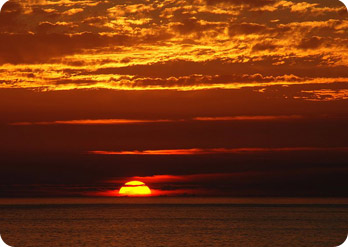A modern-day navigator can guide a ship across great distances without ever looking at the ocean or sky. Satellites and other instruments pinpoint the ship’s position to within a few feet, and provide precise readings of speed and direction.
 Navigators once used the setting sun as a navigation tool. Credit: Wikipedia
Navigators once used the setting sun as a navigation tool. Credit: WikipediaFor centuries, though, Pacific islanders sailed between islands with no instruments at all. Instead, they kept their eyes on the ocean and the sky. They used detailed knowledge of the Sun and stars, the contours of ocean swells, and the patterns of clouds and birds. This knowledge allowed them to cover hundreds or thousands of miles, hitting island targets that were often just a few miles across.
Navigation was a prized skill. Experienced navigators passed along their knowledge to apprentices, who trained for years. They had no written language, though, so everything was taught through chants, songs, and lots of repetition.
The navigator used the rising and setting points of the Sun and stars as basic markers. He’d use those points to orient himself in relation to ocean swells -- long, gentle undulations guided by prevailing winds. When the Sun was high in the sky, or if the weather was cloudy, the navigator would keep his course by maintaining the proper angle to the swells.
As he neared an island, he’d look for changes in the swells. He’d also look for birds, and for certain cloud formations. These allowed him to fine-tune his course -- a course determined by a detailed knowledge of ocean and sky passed down through generations.

